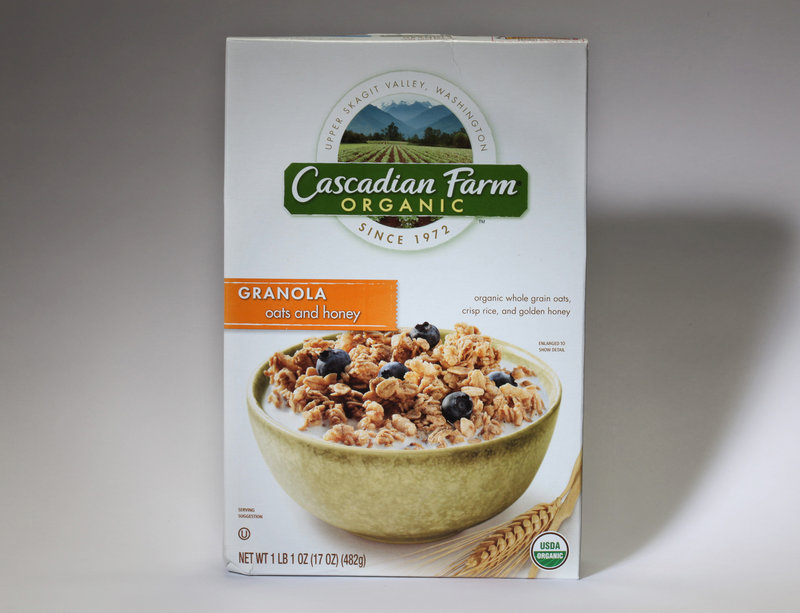Sometimes you feel like eating an embarrassingly large slice of cheesecake with nary a thought about calories, fat grams or recommended daily value of vitamin C. It’s cheesecake. If it tastes like heaven, its work here is done.
But when you sit down for a nutrition-minded meal, you don’t want stealth ingredients sabotaging your good intentions. However, packages can be deceiving. (Heart healthy! Low fat! Full serving of vegetables!) Here, we look at seven foods that appear healthful but contain ingredients you may want to avoid.
ORGANIC GRANOLA
Why we bite: Natural ingredients like rolled oats, rice, nuts and berries — plus savvy packaging — have earned granola a health halo.
Reality check: The ingredient list is short (a good thing), but the second item is sugar. One 2/3-cup serving has 14 grams of sugar — more than a single serving of Cocoa Puffs (11 grams), Lucky Charms (11 grams), Trix (12 grams) or Cookie Crisp (10 grams) cereals. The granola also has 230 calories and 6 grams of fat — not bad if you actually eat 2/3 cup. But who does that?
Try: Oatmeal. Cook your own rolled oats for a meal of 150 calories, 3 grams of fat and 1 gram of sugar. When you make it from scratch, you’re in control of the add-ons.
PEACH YOGURT
Why we bite: Good source of calcium, vitamin D, 99 percent fat-free, plus those “active cultures” we’re always hearing about.
Reality check: L. acidophilus and other cultures are good digestive aids, but yogurt is often packed with sugar. This 6-ounce container has 27 grams. A Duncan Hines Chocolate Lovers brownie with milk chocolate chunks has 18 grams. A serving of Marshmallow Fluff has 6 grams. Dessert, anyone?
Try: Plain yogurt, which usually has no added sugar. Mix in fresh fruit or even a little honey and you’ll still cut way back on your sugar intake.
BABY BRUSSELS SPROUTS AND BUTTER SAUCE
Why we bite: Brussels sprouts are packed with vitamin C and fiber and are low in calories and fat. Prewashed, cut and frozen, they’re a convenient, healthful addition to any meal.
Reality check: Because they’re frozen and sauced, these sprouts contain xanthan gum, sodium stearoyl lactylate, added color and 320 mg of sodium. (On their own, cooked Brussels contain 4 grams of sodium.)
Try: Fresh sprouts, steamed and sprinkled with some olive oil and lemon pepper. If you’re buying frozen veggies, try to avoid those with added sauces and seasonings.
ORGANIC RANCH DRESSING
Why we bite: It’s organic, and you pair it with vegetables, either as a dip or a salad dressing. Sounds innocent enough.
Reality check: Organic or not, this dressing packs 150 calories and 16 grams of fat into 2 tablespoons. Considering few of us limit ourselves to 2 tablespoons, we’re in danger of turning a healthful meal or side dish into a calorie- and fat-laden mistake. Read the ingredients list (soybean oil, vinegar, cane sugar, salt, etc.), and you realize it offers zero nutritional benefits.
Try: A little balsamic vinegar (high in antioxidants) and olive oil (rich in monosaturated fat, which can lower your “bad” cholesterol), and lower your calorie and fat intake.
ACAI MIXED BERRY JUICE
Why we bite: The label — boasting a “full serving of vegetables,” “full serving of fruits,” the American Heart Association check mark, plus the uber-trendy acai berry — makes this bottle hard to resist.
Reality check: At 110 calories and 26 grams of sugar, an 8-ounce glass has almost as many calories as a serving of Oreo cookies and twice the sugar. The vitamin C content is 100 percent of your recommended daily value, but vitamins A and E are comparatively low at 15 and 10 percent.
Try: A 100 percent vegetable juice, which contains 50 calories, 6 grams of sugar per serving, plus 100 percent of vitamins A, C and E.
HONEY ROASTED TURKEY BREAST
Why we bite: Sliced turkey is often touted as a low-calorie, low-fat lunch staple. And at 50 calories and 0.5 grams of fat per 4-slice serving, this one is a lean and tasty treat.
Reality check: The sodium content, especially in honey or smoked varieties, is high. This brand has 550 mg per serving, or 23 percent of your daily value. Throw in an extra few slices and you’re up to half your daily value on one sandwich — not counting the condiments and bread. Many brands also contain sodium phosphate and sodium nitrate as preservatives.
Try: Nitrate-free varieties. Applegate Farms’ organic smoked and organic roasted turkey breast has a more reasonable 360 mg of sodium per serving.
CHUNKY APPLESAUCE
Why we bite: It’s cheap. It lasts forever. Kids eat it up. It’s made of apples. What’s not to love?
Reality check: The apples have been peeled and cooked to mush, rendering them nutritionally vacant. Most brands, this one included, have zero percent of the recommended daily value of vitamins C and A. And some add high fructose corn syrup to enhance the flavor.
Try: An apple. Depending on its size, an unpeeled apple contains between 10 and 15 percent of your daily value of vitamin C and up to 5 grams of fiber.
Copy the Story Link
Send questions/comments to the editors.



Success. Please wait for the page to reload. If the page does not reload within 5 seconds, please refresh the page.
Enter your email and password to access comments.
Hi, to comment on stories you must . This profile is in addition to your subscription and website login.
Already have a commenting profile? .
Invalid username/password.
Please check your email to confirm and complete your registration.
Only subscribers are eligible to post comments. Please subscribe or login first for digital access. Here’s why.
Use the form below to reset your password. When you've submitted your account email, we will send an email with a reset code.